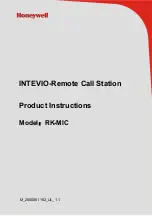
PDW90 Point to Multi-Point Wireless Instruction Manual
12
Relays Connector
The relays module includes two mechanical relays. Relay connections
are made to the six-terminal connector shown to the right.
Each relay’s C terminal is common only to the normally open (NO) and
normally closed (NC) contacts of the corresponding relay.
If a field unit’s digital input channel is mapped to a relay module chan-
nel on the base station, the effect may be opposite of what is expected.
An open connection at the digital input will result in the relay going into
an active state. This is because the digital input channels are active
low. This can be changed by swapping the NO and NC connections to
the relay channel.
Switching Inductive Loads
The use of suppressors (snubbers) is strongly recommended when switching inductive loads to prevent
disrupting the microprocessor’s operation. The suppressors also prolong the life of the relay contacts.
Suppression can be obtained with resistor-capacitor (RC) networks assembled by the user or purchased
as complete assemblies. Refer to the following circuits for RC network assembly and installation:
Figure 7. AC and DC Loads Protection
Choose R and C as follows:
R: 0.5 to 1 Ω for each volt across the contacts
C: 0.5 to 1 µF for each amp through closed contacts
Notes:
1. Use capacitors rated for 250 VAC.
2. RC networks may affect load release time of solenoid loads. Check to confirm proper operation.
3. Install the RC network at the device's relay screw terminals. An RC network may also be installed
across the load. Experiment for best results.
Figure 8. Low Voltage DC Loads Protection
RC Networks Available from Precision Digital
RC networks are available from Precision Digital and should be applied to each relay contact switching an
inductive load. Part number: PDX6901.
Note: Relays are de-rated to 1/14th HP (50 watts) with an inductive load.
C
R
C
R
C
NC
NO
C
NC
NO
Figure 6. Base Station
Relays Connection
NO NC C
1
2
RELAY
NO NC C
Use a diode with a reverse
breakdown voltage two to
three times the circuit voltage
and forward current at least as
large as the load current.
www.
.com
1.800.561.8187













































